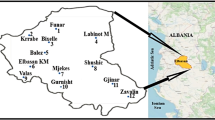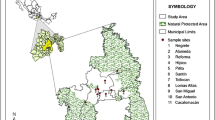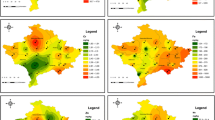Abstract
Different sampling media (moss, lichen and attic dust) were used for monitoring the distribution of 15 elements, including certain trace elements, in the vicinity of an intensively exploited copper mine in the east of the Republic of Macedonia. Moss species (Hypnum cupressiforme and Campothecium lutescens), epiphytic lichens (Hypogymnia physodes and Evernia prunastri) and attic dust were collected for comparative analysis for monitoring air pollution. In both cases (lithological and anthropogenic affected areas) for the distribution of elements, the sampling media follows the expression capabilities: attic dust > moss > lichens. Enrichment factors M/L—moss vs. lichen, for plant response to elements distribution and D/L—attic dust vs. lichen, for historical response of elements distribution were significant for Cu and Ni, which were singled out as the main markers for anthropogenic and geogenic distribution. The factor analysis highlighted geogenic (F1: Ni-Cr-Cd-Fe-Al-K-Mn-Zn) and anthropogenic (F2: As-Cu-Pb) association of elements from three types of media samples. For anthropogenic affected areas, T value and F value for Cu content were significant at p < 0.05 and higher enrichment factors were obtained for lichen, moss and attic dust media (3.8, 5.0 and 5.7, respectively). Spatial distribution for element deposition (with emphasis on Cu and Ni) is not disturbed by the significant differences in the sampling media matrix. Treated sample materials (attic dust, moss, lichen) are shown to be useful in determining an anthropogenic impact, as well as the chemical properties or geological background on orographic diverse terrain in the presence of complex geological structure.







Similar content being viewed by others
References
Alijagić J, Šajn R (2011) Distribution of chemical elements in an old metallurgical area, Zenica (Bosnia and Herzegovina). Geoderma 162:71–85
Artiola JF, Pepper I, Brussean L (2004) Environmental monitoring and characterization. Elsevier Academic Press, San Diego
Ashraf MA, Maah MJ, Yusoff I (2011) Heavy metals accumulation in plants growing in ex tin mining catchment. Int J Environ Sci Tech 8:401–416
Balabanova B, Stafilov T, Bačeva K, Šajn R (2010) Biomontorıng of atmospherıc pollution wıth heavy metals ın the copper mıne vıcınıty located near Radovıš, Republıc of Macedonıa. J Environ Sci Health, Part A 45:1504–1518
Balabanova B, Stafilov T, Šajn R, Bačeva K (2011) Distribution of chemical ele-ments in attic dust as reflection of lithology and anthropogenic influence in the vicinity of copper mine and flotation. Arch Environ Con Tox 61:173–184
Balabanova B, Stafilov T, Šajn R, Bačeva K (2012) Characterisation of heavy metals in lichen species Hypogymnia Physodes and Evernia Prunastri due to biomonitoring of air pollution in the vicinity of copper mine. Inter J Environ Res 6:779–794
Barandovski L, Cekova M, Frontasyeva MV, Pavlov SS, Stafilov T, Steinnes E, Urumov V (2008) Atmospheric deposition of trace element pollutants in Macedonia studied by the moss biomonitoring technique. Environ Monit Assess 138:107–118
Branquinho C, Catarino F, Brown DH, Pereira MJ, Soares A (1999) Improving the use of lichens as biomonitors of atmospheric pollution. Sci Total Environ 232:67–77
Chakrabortty S, Tryambakro-Paratkar G (2006) Biomonitoring of trace element air pollution using mosses. Aerosol Air Qual Res 6:247–258
Culicov OA, Mocanu R, Frontasyeva MV, Yurukova L, Steinnes E (2005) Active moss biomonitoring applied to an industrial site in Romania: relative accumulation of 36 elements in moss-bags. Environ Monit Assess 108:229–240
Cyrys J, Stölzel M, Heinrich J, Kreyling WG, Menzel N, Wittmaack K, Tuch T, Wichmann HE (2003) Elemental composition and sources of fine and ultrafine ambient particles in Erfurt, Germany. Sci Total Environ 305:143–156
Filzmoser P, Garrett RG, Reimann C (2005) Multivariate outlier detection in exploration geochemistry. Comput Geosci 31:579–587
Garty J (2001) Biomonitoring atmospheric heavy metals with lichens: theory and application. Crit Rev Plant Sci 20:309–371
Gosar M, Šajn R, Biester H (2006) Binding of mercury in soils and attic dust in the Idrija mercury mine area (Slovenia). Sci Total Environ 369:150–162
Hristov S, Karajovanovič M, Stračkov M (1965) Basic geological map of SFRJ, sheet Štip. Federal Geological Survey, Belgrade
Järup L (2003) Hazards of heavy metal contamination. Brit Med Bull 68:167–182
Jeffrey J, Davisa B, Gulson BL (2005) Ceiling (attic) dust: a “museum” of contamination and potential hazard. Environ Res 99:177–194
Jeran Z, Jačimović R, Batič F, Mavsar R (2002) Lichens as integrating air pollution monitors. Environ Poll 120:107–113
Market B (2007) Definition principles for bioindication and biomonitoring of trace metals in the environment. J Trace Elem Med Bio 21:77–82
Onianwa PC (2001) Monitoring atmospheric metal pollution: a review of the use of mosses as indicators. Environ Monit Assess 71:13–50
Pacyna EG, Pacyna JM, Fudala J, Strzelecka-Jastrzab E, Hlawiczka S, Panasiuk D, Nitter S, Pregger T, Pfeiffer H, Friedrich R (2007) Current and future emissions of selected heavy metals to the atmosphere from anthropogenic sources in Europe. Atmos Environ 41:8557–8566
Rakićević T, Dumurdzanov N, Petkovski M (1969) Basic geological map of SFRJ, sheet Štip, M 1:100,000 (map & interpreter). Federal Geological Survey, Belgrade
Reimann C, Filzmoser P, Garrett RG (2002) Factor analysis applied to regional geochemical data: problems and possibilities. Appl Geochem 17:185–206
Šajn R (1999) Geokemične lastnosti urbanih sedimentov na ozemlju Slovenije. Geological Survey of Slovenia, Ljubljana
Šajn R (2003) Distribution of chemical elements in attic dust and soil as reflection of lithology and anthropogenic influence in Slovenia. Journal de Physique 107:1173–1176
Šajn R (2005) Using attic dust and soil for the separation of anthropogenic and geogenic elemental distributions in an old metallurgic area (Celje, Slovenia). Geochem-Explor Env A 5:59–67
Šajn R (2006) Factor analysis of soil and attic-dust to separate mining and metallurgy influence, Meza valley, Slovenia. Math Geol 38:735–746
Stafilov T, Balabanova B, Šajn R, Bačeva K, Boev B (2010) Geochemical atlas of Radoviš and the environs and the distribution of heavy metals in the air. Faculty of Natural Sciences and Mathematics, Skopje
Stefanova V, Neviealkov R, Moritz R (2004) Magmatism of the Borov Dol copper occurrence. In: Kovachev V (ed) Proceedings on the annual scientific conference of the Bulgarian Geological Society. House of Science and Technology, Sofia
Tuba Z, Csintalanm Z, Nagy Z, Szente K, Takács Z (2007) Sampling of terricolous lichen and moss species for trace element analysis, with special reference to bioindication of air pollution. In: Markert B (ed) Environmental sampling for trace analysis. Wiley, Germany
Vallero D (2008) Fundamentals of air pollution, 4th edn. Academic Press Elsevier, New York
Žibret G (2008) Determination of historical emission of heavy metals into the atmosphere: Celje case study. Environ Geol 56:189–196
Žibret G (2012) Impact of dust filter installation in ironworks and construction on brownfield area on the toxic metal concentration in street and house dust (Celje, Slovenia). Ambio 41:292–301
Žibret G, Rokavec D (2010) Household dust and street sediment as an indicator of recent heavy metals in atmospheric emissions: a case study on a previously heavily contaminated area. Environ Earth Sci 61:443–453
Žibret G, Šajn R (2008) Modeling of atmospheric dispersion of heavy metals in the Celje area, Slovenia. J Geochem Explor 97:29–41
Acknowledgments
The authors express their gratitude to the anonymous referees for their constructive comments on earlier drafts of this article.
Author information
Authors and Affiliations
Corresponding author
Rights and permissions
About this article
Cite this article
Balabanova, B., Stafilov, T., Šajn, R. et al. Comparison of response of moss, lichens and attic dust to geology and atmospheric pollution from copper mine. Int. J. Environ. Sci. Technol. 11, 517–528 (2014). https://doi.org/10.1007/s13762-013-0262-8
Received:
Revised:
Accepted:
Published:
Issue Date:
DOI: https://doi.org/10.1007/s13762-013-0262-8




